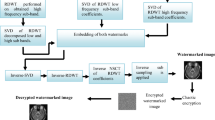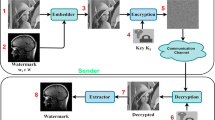Abstract
Nowadays, secure medical data transmission is an essential issue in telemedicine through unsecured channels. Watermarking methods are widely used to provide optimal security for medical image transmission. In this method, a secure and blind watermarking algorithm based on Integer Wavelet Transform (IWT), Least Significant Bit (LSB), and chaotic sequences (ILC) with a high capacity for grayscale medical and non-medical images is ILC. In this scheme, the high-level security is achieved by chaotic sequences that are applied for watermark encryption and determining the location of host blocks and host coefficients in the embedding process. At first, the cover medical image is divided into two distinct parts: the region of interest (ROI) and the region of non-interest (RONI) areas. Due to the high sensitivity of the ROI data in disease diagnosis, no embedding is done in this area. An ROI integrity check data (ICR), produced by some significant features from ROI, to detect tampered blocks inside this area. The main watermark, which is the encryption of ICR along with the patient’s personal and medical information, is embedded in the middle-frequency at the first and second levels of IWT sub-bands. Furthermore, to verify the watermark, integrity check data (ICW) is produced and sent along with other essential data to the receiver. For identifying authentication purposes, the physician’s signature is embedded at the third level (LL3) sub-band of IWT which has the highest energy and robustness. Moreover, the algorithm is flexible for using different sizes of text watermarks and it guarantees a high payload capacity. It is noteworthy the maximum lengths of text watermarks used in the method for 512×512 and 1024×1024 images are 47,784 and 164,620 bits, respectively. Although the size of the embedded watermark increases with the size of the ROI area, the image transparency remains almost constant and also the watermark is extracted with a bit error rate of zero. By doing various analyses, the experimental results represent superior imperceptibility by an average PSNR value of 75 dB. This method provides high imperceptibility and robustness against various attacks compared with state-of-the-art algorithms.



























Similar content being viewed by others
References
ALabaichi A, Al-Dabbas MA, Salih A (2020) Image steganography using least significant bit and secret map techniques. International journal of electrical & computer engineering (2088-8708) 10
Alotaibi RA, Elrefaei LA (2019) Text-image watermarking based on integer wavelet transform (IWT) and discrete cosine transform (DCT). Appl Comput Info 15(2):191–202
Anand A, Singh AK (2020) An improved DWT-SVD domain watermarking for medical information security. Comput Commun 152:72–80
Araghi TK, Manaf AA (2019) An enhanced hybrid image watermarking scheme for security of medical and non-medical images based on DWT and 2-D SVD. Futur Gener Comput Syst 101:1223–1246
Arora M, Khurana M (2020) Secure image encryption technique based on jigsaw transform and chaotic scrambling using digital image watermarking. Opt Quant Electron 52(2):59
Bhinder P, Jindal N, Singh K (2019) An improved robust image-adaptive watermarking with two watermarks using statistical decoder. Multimed Tools Appl 79(1):183–217
Cedillo-Hernandez M, Cedillo-Hernandez A, Nakano-Miyatake M, Perez-Meana H (2020) Improving the management of medical imaging by using robust and secure dual watermarking. Biomed Signal Process Control 56:101695
Chauhan DS, Singh AK, Kumar B, Saini JP (2017) Quantization based multiple medical information watermarking for secure e-health. Multimed Tools Appl 78(4):3911–3923
Chun-peng W, Xing-yuan W, Zhi-qiu X (2016) Geometrically invariant image watermarking based on fast radial harmonic Fourier moments. Signal Process Image Commun 45:10–23
Elhoseny M, Ramírez-González G, Abu-Elnasr OM, Shawkat SA, Arunkumar N, Farouk A (2018) Secure medical data transmission model for IoT-based healthcare systems. Ieee Access 6:20596–20608
Ernawan F, Ariatmanto D (2019) Image watermarking based on integer wavelet transform-singular value decomposition with variance pixels. Int J Electr Compu Eng (IJECE) 9(3):2185–2195
Ernawan F, Kabir MN (2018) A block-based RDWT-SVD image watermarking method using human visual system characteristics. Vis Comput 36(1):19–37
Eswaraiah R, Reddy ES (2015) Robust medical image watermarking technique for accurate detection of tampers inside region of interest and recovering original region of interest. IET Image Process 9(8):615–625
Feng L, Wu Z, Long X (2016) Fast image diffusion for feature detection and description. Int J Comput Theory Eng 8(1):58–62
Gull S, Loan NA, Parah SA, Sheikh JA, Bhat GM (2018) An efficient watermarking technique for tamper detection and localization of medical images. J Ambient Intell Humaniz Comput 12:1–0
Gupta S, Goyal A, Bhushan B (2012) Information hiding using least significant bit steganography and cryptography. Int J Mod Educ Comput Sci 4(6):27–34
Khadam U, Iqbal MM, Azam MA, Khalid S, Rho S, Chilamkurti N (2019) Digital watermarking technique for text document protection using data mining analysis. IEEE Access 7:64955–64965
Lee S, Yoo CD, Kalker T (2007) Reversible image watermarking based on integer-to-integer wavelet transform. IEEE Trans Inf Forensics Secur 2(3):321–330
Liu X, Wang Y, Du J, Liao S, Lou J, Zou B (2018) Robust hybrid image watermarking scheme based on KAZE features and IWT-SVD. Multimed Tools Appl 78(5):6355–6384
Makbol NM, Khoo BE, Rassem TH (2016) Block-based discrete wavelet transform-singular value decomposition image watermarking scheme using human visual system characteristics. IET Image Process 10(1):34–52
Nazari M, Ahmadi ID (2020) A novel chaotic steganography method with three approaches for color and grayscale images based on FIS and DCT with flexible capacity. Multimed Tools Appl 1:1–32
Nazari M, Sharif A, Mollaeefar M (2017) An improved method for digital image fragile watermarking based on chaotic maps. Multimed Tools Appl 76(15):16107–16123
Priya S, Santhi B (2019) A novel visual medical image encryption for secure transmission of authenticated watermarked medical images. Mobile networks and applications 1-8
Salimi L, Haghighi A, Fathi A (2020) A novel watermarking method based on differential evolutionary algorithm and wavelet transform. Multimed Tools Appl 4:1–8
Singh AK (2016) Improved hybrid algorithm for robust and imperceptible multiple watermarking using digital images. Multimed Tools Appl 76(6):8881–8900
Singh AK (2019) Robust and distortion control dual watermarking in LWT domain using DCT and error correction code for color medical image. Multimed Tools Appl 78(21):30523–30533
Singh AK, Dave M, Mohan A (2015) Multilevel encrypted text watermarking on medical images using spread-spectrum in DWT domain. Wirel Pers Commun 83(3):2133–2150
Sivasubramanian N, Konganathan G (2020) A novel semi fragile watermarking technique for tamper detection and recovery using IWT and DCT. Computing 13:1–20
Swaraja K, Meenakshi K, Kora P (2020) An optimized blind dual medical image watermarking framework for tamper localization and content authentication in secured telemedicine. Biomed Signal Process Control 55:101665
Thakkar FN, Srivastava VK (2016) A blind medical image watermarking: DWT-SVD based robust and secure approach for telemedicine applications. Multimed Tools Appl 76(3):3669–3697
Thakur S, Singh AK, Ghrera SP (2018) NSCT domain–based secure multiple-watermarking technique through lightweight encryption for medical images. Concurrency and Computation: Practice and Experience e5108
Thakur S, Singh AK, Ghrera SP, Elhoseny M (2018) Multi-layer security of medical data through watermarking and chaotic encryption for tele-health applications. Multimed Tools Appl 78(3):3457–3470
Thakur S, Singh AK, Ghrera SP, Mohan A (2018) Chaotic based secure watermarking approach for medical images. Multimed Tools Appl 20:1–4
Thanki R, Borra S, Dwivedi V, Borisagar K (2017) An efficient medical image watermarking scheme based on FDCuT–DCT. Eng sci tech int j 20(4):1366–1379
Vaidya SP, Mouli PC (2020) A robust and blind watermarking for color videos using redundant wavelet domain and SVD. InSmart computing paradigms: new progresses and challenges (pp. 11-17). Springer, Singapore
Valandar MY, Barani MJ, Ayubi P (2019) A blind and robust color images watermarking method based on block transform and secured by modified 3-dimensional Hénon map. Soft Comput 24(2):771–794
Wang CP, Wang XY, Chen XJ, Zhang C (2017) Robust zero-watermarking algorithm based on polar complex exponential transform and logistic mapping. Multimed Tools Appl 76(24):26355–26376
Wang C, Wang X, Li Y, Xia Z, Zhang C (2018) Quaternion polar harmonic Fourier moments for color images. Inf Sci 450:141–156
Wang C, Wang X, Xia Z, Ma B, Shi YQ (2019) Image description with polar harmonic Fourier moments. IEEE Trans Circuits Syst Video Technol
Wang C, Wang X, Xia Z, Zhang C (2019) Ternary radial harmonic Fourier moments based robust stereo image zero-watermarking algorithm. Inf Sci 470:109–120
Wang CP, Wang XY, Xia ZQ, Zhang C, Chen XJ (2016) Geometrically resilient color image zero-watermarking algorithm based on quaternion exponent moments. J Vis Commun Image Represent 41:247–259
Wang C, Wang X, Zhang C, Xia Z (2017) Geometric correction based color image watermarking using fuzzy least squares support vector machine and Bessel K form distribution. Signal Process 134:197–208
Wu X, Li J, Tu R, Cheng J, Bhatti UA, Ma J (2018) Contourlet-DCT based multiple robust watermarkings for medical images. Multimed Tools Appl 78(7):8463–8480
Xia Z, Wang X, Li X, Wang C, Unar S, Wang M, Zhao T (2019) Efficient copyright protection for three CT images based on quaternion polar harmonic Fourier moments. Signal Process 164:368–379
Xia Z, Wang X, Wang M, Unar S, Wang C, Liu Y, Li X (2019) Geometrically invariant color medical image null-watermarking based on precise quaternion polar harmonic Fourier moments. IEEE Access 7:122544–122560
Xia Z, Wang X, Zhou W, Li R, Wang C, Zhang C (2019) Color medical image lossless watermarking using chaotic system and accurate quaternion polar harmonic transforms. Signal Process 157:108–118
Zainol Z, Teh JS, Alawida M (2020) A new chaotic image watermarking scheme based on SVD and IWT. IEEE Access 8:43391–43406
Zear A, Singh AK, Kumar P (2018) A ILC secure multiple watermarking technique based on DWT, DCT, and SVD for application in medicine. Multimed Tools Appl 77(4):4863–4882
Author information
Authors and Affiliations
Corresponding author
Additional information
Publisher’s note
Springer Nature remains neutral with regard to jurisdictional claims in published maps and institutional affiliations.
Rights and permissions
About this article
Cite this article
Nazari, M., Mehrabian, M. A novel chaotic IWT-LSB blind watermarking approach with flexible capacity for secure transmission of authenticated medical images. Multimed Tools Appl 80, 10615–10655 (2021). https://doi.org/10.1007/s11042-020-10032-2
Received:
Revised:
Accepted:
Published:
Issue Date:
DOI: https://doi.org/10.1007/s11042-020-10032-2




